The Chemistry of Natural Products (2nd Ed., Softcover reprint of the original 2nd ed. 1993)
Langue : Anglais
Coordonnateur : Thomson R.H.

This book reviews in a concise and manageable way the progress in all key areas of natural products chemistry since 1984. The most significant advances are highlighted over a wide field of chemistry, structure, synthesis and biosynthesis. This book provides a unique and superb entry into the vast literature on the subject.
1 Carbohydrates.- 1.1 Introduction.- 1.2 Recent developments in O-glycosidation methodology.- 1.3 Recent developments in C-glycoside synthesis.- 1.4 Synthesis of antibiotic sugars.- 1.5 Use of carbohydrates as chiral templates and reagents for asymmetric synthesis.- 1.5.1 Asymmetric reduction.- 1.5.2 Enantioselective alkylation of carbohydrate derived nucleophiles.- 1.5.3 Enantioselective alkylation of carbohydrate derived electrophiles.- 1.5.4 Monosaccharides as chiral auxiliaries for cycloaddition reactions.- 1.6 Use of carbohydrates as chiral starting materials for the synthesis of enantiomerically pure natural products.- References.- 2 Aromatic compounds.- 2.1 Introduction.- 2.2 Benzenoids.- 2.3 Coumarins.- 2.4 Isocoumarins, chromanones, chromones and cannabinoids.- 2.5 Macrocyclic lactones.- 2.6 Pyrones, butenolides, lignans and benzofurans.- 2.7 Terphenyls.- 2.8 Flavonoids.- 2.9 Xanthones and benzophenones.- 2.10 Naphthalenes and naphthoquinones.- 2.11 Anthraquinones.- 2.12 Anthracyclines.- 2.13 Some other polycyclic antibiotics.- 2.14 Ansamycins.- References.- 3 Terpenoids.- 3.1 Introduction.- 3.2 Monoterpenoids.- 3.3 Sesquiterpenoids.- 3.4 Diterpenoids.- 3.5 Sesterterpenoids.- 3.6 Triterpenoids.- 3.7 Carotenoids.- References.- 4 Steroids.- 4.1 Introduction.- 4.2 Molecular rearrangement.- 4.3 Remote functionalisation.- 4.4 Photochemical reactions.- 4.5 Partial synthesis.- 4.5.1 Oestranes.- 4.5.2 Androstanes.- 4.5.3 Pregnanes.- 4.5.4 Cholanes.- 4.5.5 Cardenolides and bufadienolides.- 4.5.6 Vitamins D.- 4.5.7 Cholestanes and derivatives.- References.- 5 Amino acids, peptides and proteins.- 5.1 Introduction.- 5.2 Amino acids.- 5.2.1 Synthesis.- 5.2.2 New naturally occurring amino acids.- 5.3 Peptides.- 5.3.1 Synthesis.- 5.3.2 Synthesis of glycopeptides.- 5.3.3 Synthesis of phosphorylated peptides.- 5.3.4 Post-translational modifications.- 5.3.5 Design of peptide-based pharmaceuticals.- 5.3.6 New peptides from natural sources.- 5.4 Techniques for structural elucidation.- 5.4.1 X-ray crystallography.- 5.4.2 N.m.r. spectroscopy.- 5.4.3 Molecular modelling.- 5.5 Proteins.- 5.5.1 Incorporation of unnatural amino acids.- 5.5.2 Purification and analysis.- 5.5.3 Sequences, databases and protein folding.- 5.6 Appendix.- 5.6.1 Useful books.- 5.6.2 Databases.- References.- 6 Alkaloids.- 6.1 Introduction.- 6.2 Biomimetic studies.- 6.2.1 Biomimetic synthesis of Iboga and Aspidosperma alkaloids.- 6.2.2 Biomimetic routes to Daphniphyllum alkaloids.- 6.3 Synthesis.- 6.3.1 Reserpine.- 6.3.2 Other yohimbine and heteroyohimbine alkaloids.- 6.4 Marine alkaloids.- 6.4.1 The manzamines.- 6.4.2 Biosynthetic origin of manzamines.- 6.4.3 Total synthesis of manzamine C.- 6.4.4 Synthetic approaches to manzamine A.- References.- 7 Nucleosides, nucleotides and nucleic acids.- 7.1 Introduction.- 7.2 Nucleosides.- 7.2.1 Nucleoside synthesis: general methods.- 7.2.2 Nucleosides containing modified sugars.- 7.2.3 Other nucleosides of interest.- 7.2.4 Some useful and novel reactions.- 7.3 Nucleotides.- 7.3.1 Nucleoside monophosphates and their analogues.- 7.3.2 Cyclic nucleotides.- 7.3.3 Nucleoside polyphosphates and their analogues.- 7.4 Nucleic acids.- 7.4.1 Oligodeoxyribonucleotide synthesis.- 7.4.2 Oligoribonucleotide synthesis.- 7.4.3 Oligonucleotides containing modified internucleotidic links.- 7.4.4 Nucleic acid sequencing.- 7.5 Supplementary reading.- References.- 8 Porphyrins.- 8.1 General introduction.- 8.2 Macrocycle biosynthesis.- 8.2.1 Introduction.- 8.2.2 Substitution pattern of uroporphyrinogen III.- 8.2.3 Biosynthesis of vitamin B12.- 8.3 Haemoprotein model compounds.- 8.3.1 Introduction.- 8.3.2 Supramolecular effects in haemoprotein model compounds.- 8.3.3 Cytochrome P-450 models.- 8.4 Porphyrins with easily oxidisable substituents.- 8.4.1 Introduction.- 8.4.2 Mesotetrakis (3,5-di-t-butyl-4-hydroxyphenyl)porphyrin.- 8.4.3 Mesotetrakis (pyrogallyl) porphyrin.- 8.5 Utilisation of porphyrin excited states.- 8.5.1 Introduction.- 8.5.2 Modelling photosynthesis.- 8.5.3 Solar energy conversion.- 8.6 Porphyrins in photodynamic therapy.- 8.6.1 Introduction.- 8.6.2 Haematoporphyrin derivative, HpD.- 8.6.3 Second generation porphyrins.- 8.6.4 New approaches to photosensitiser delivery.- 8.6.5 Mechanism of photodynamic action.- 8.6.6 Photosensitising porphyrins as herbicides.- 8.7 DNA-porphyrin interactions.- 8.7.1 Introduction.- 8.7.2 DNA cleavage.- 8.7.3 DNA binding.- 8.8 Porphyrins as novel materials.- 8.8.1 Introduction: solid state and liquid crystalline phenomena.- 8.8.2 Porphyrins in molecular electronics.- 8.9 Porphyrins with liquid crystalline properties.- 8.9.1 Introduction.- 8.9.2 Porphyrins with discotic phases.- References.- 9 Aliphatic compounds.- 9.1 Introduction.- 9.2 Semiochemicals.- 9.2.1 Lepidopteran pheromones.- 9.2.2 Methyl substituted aliphatic pheromones.- 9.2.3 Unbridged spiroketals.- 9.3 Development of synthetic technology.- 9.3.1 Bridged spiroketal semiochemicals of bark beetles.- 9.3.2 Organosulphur semiochemicals.- 9.4 Marine natural products.- 9.4.1 Palytoxin.- 9.4.2 Okadaic acid, dinophysistoxins and acanthifolicin.- 9.4.3 Fused ring polyethers.- 9.5 Enyne-allene and enediyne antibiotics.- 9.5.1 Neocarzinostatin.- 9.5.2 Trisulphide triggered enediyne antibiotics: the esperamicins and calicheamicins.- 9.5.3 Dynemicins.- References.- Chemical abbreviations and acronyms.
'The first editon of The Chemistry of Natural Products was published in 1985, and the various chapters then described progress in the ten years preceding 1982/3. This new edition covers the period between then and mid-1992, and in most respects it is a new book rather than a new edition of an existing test. Although the book has the same format as its predecessor, the detailed content and may of the authors of the individual chapters are different...Each chapter has a useful list of literature references. The book is well-produced and can be recommended as providing a varied, interesting, and useful account of progress in different aspects of natural product chemistry over the last ten years.'National Products Reports'This well written and presented book summarises much elegant chemistry which is accompanied by clearly drawn and well explained reaction schemes...it admirably achieves its purpose...'The Pharmaceutical Journal
Date de parution : 11-2012
Ouvrage de 453 p.
15.5x23.5 cm
Disponible chez l'éditeur (délai d'approvisionnement : 15 jours).
Prix indicatif 210,99 €
Ajouter au panierThèmes de The Chemistry of Natural Products :
Mots-clés :
Amino acid; Cycloaddition; DNA; Nucleotide; Rearrangement; Translation; natural product; proteins
© 2024 LAVOISIER S.A.S.



